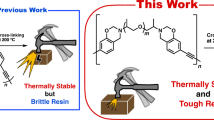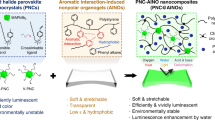Abstract
The birefringent properties of poly(phosphonate)s and poly(thiophosphonate)s possessing various bisphenol structures were investigated. The CR values (orientational birefringence) of the poly(phosphonate)s and the poly(thiophosphonate)s range from −0.3 × 10−9 to + 1.3 × 10−9 Pa−1 and from −0.6 × 10−9 to + 0.8 × 10−9 Pa−1, respectively, which are lower than those of the corresponding bisphenol A-based polymers. The CD values (photoelastic birefringence), which range from + 4.0 × 10−11 to + 4.9 × 10−11 Pa−1, are also lower than those of the corresponding bisphenol A-based polymers.
Similar content being viewed by others
Introduction
Low birefringent polymers are very important functional materials for high-performance optical devices. For example, low birefringent properties are essential to maintain the polarization state of the transmitted light for some flat-panel display films and to achieve fine focusing for plastic lens modules.
Among the several types of birefringence in polymers, orientational birefringence and photoelastic birefringence are important for the optical fields. Orientational birefringence is observed when polymers with optically anisotropic repeating units are oriented and can be expressed as follows [1]:
where Δn, CR, and σ are the birefringence, the stress-optical coefficient for the rubbery state, and the stress, respectively. Photoelastic birefringence is observed when glassy polymers are subjected to stress and can be expressed as follows [1]:
where CD is known as the photoelastic coefficient. The coefficients (CR and CD) are useful to quantitatively compare birefringence among a wide variety of polymers.
A number of low birefringent polymers have been developed. For example, polymers composed of aliphatic building blocks such as poly(cycloolefin)s and their copolymers have CR values ranging from 0.1 × 10−9 to 2.0 × 10−9 Pa−1 and have CD values ranging from 0.4 × 10−11 to 3.3 × 10−11 Pa−1 [2,3,4], which are remarkably lower than those of conventional engineering plastics, such as a 2,2-bis(4-hydroxyphenyl)propane (bisphenol A)-based poly(carbonate) (CR = + 5.6 × 10−9 Pa−1 and CD = + 8.9 × 10−11 Pa−1) [5]. It has also been reported that both the orientational birefringence and photoelastic birefringence of polymers can be canceled by the terpolymerization of three kinds of methacrylates with positive–positive, positive–negative, and negative–negative orientational and photoelastic birefringence [6]. Although conventional engineering plastics generally exhibit high birefringence, as mentioned above, the introduction of aromatic structures at a direction perpendicular to the main chain has successfully realized low birefringent polymers. For example, poly(carbonate)s possessing phenyl substituents perpendicularly oriented to the main chain direction and poly(ester)s possessing 9,9-diarylfluorene moieties have been reported as achieving low CR values in the range from 0.6 × 10−9 to 2.3 × 10−9 Pa−1 and from 0.3 × 10−9 to 1.8 × 10−9 Pa−1, respectively [7,8,9].
We have recently reported the low birefringent properties of the bisphenol A-based poly(phosphonate) and poly(thiophosphonate) [5]. Their CR and CD values ranged from + 1.2 × 10−9 to + 1.5 × 10−9 Pa−1 and from + 5.7 × 10−11 to + 6.1 × 10−11 Pa−1, respectively, which are lower than those of the conventional bisphenol A-based polymers having carbonate, ester, and ether linkers in the main chains.
In addition to the bisphenol A-based poly((thio)phosphonate)s, poly((thio)phosphonate)s possessing various bisphenol structures have been synthesized, and the highly refractive nature of some of these polymers has been described independently by Shobha et al., Macdonald et al., and us [10,11,12]. These results indicate that poly((thio)phosphonate)s may serve as novel plastic lens materials. Although low birefringent properties are required for plastic lens materials, as mentioned above, those properties of poly((thio)phosphonate)s have scarcely been studied except in our previous paper [5]. In this paper, we wish to describe the orientational birefringence and the photoelastic birefringence (CR and CD values, respectively) of poly((thio)phosphonate)s possessing various bisphenol structures.
Experimental procedures
The syntheses of P1O, P1S, P2S, and P4S have been described in our previous paper, and P2O–P5O and P5S were likewise synthesized (Fig. 1 and Table 1) [12]. A 4,4′-biphenol-based poly(phosphonate) (P6O) was synthesized according to the procedure reported by Shobha et al. [10]. All the polymers were fully characterized by 1H, 13C, and 31P nuclear magnetic resonance (NMR) spectroscopy (see the Supplementary Information).
The orientational birefringence and photoelastic birefringence (CR and CD values, respectively) of the polymers were evaluated according to the method reported by Osaki and coworkers [13].
Results and discussion
The number-average molecular weights (Mn) and weight-average molecular weights (Mw) of the polymers (P1O–P6O, P1S, P2S, P4S, and P5S) were estimated by size-exclusion chromatography (SEC) and are in the range of 8,500–53,300 and 46,500–150,100, respectively, which are high enough to obtain freestanding films (Table 1).
The thermal properties of the polymers were investigated by thermogravimetric analysis (TGA) and differential scanning calorimetric analysis (DSC). From the TGA measurements, the polymers (P1O–P6O, P1S, P2S, P4S, and P5S) exhibit excellent thermal stabilities: their 5% weight loss temperatures were found to be greater than 420 °C (Fig. S19). The glass transition temperatures of the polymers (P1O–P6O, P1S, P2S, P4S, and P5S) are in the range of 107–173 °C, which are suitable for the injection-molding process (Fig. S20).
The orientational birefringence (CR values) of the polymers was evaluated based on Eq. (1). The linear relationships between the birefringence (Δn) and the stretching stress (σ) were observed (Fig. S23), and the CR values of the polymers were determined from the slopes. The CR values of the poly(phosphonate)s (P2O–P4O) and the poly(thiophosphonate)s (P2S and P4S) range from + 0.4 × 10−9 to + 1.3 × 10−9 Pa−1 and from + 0.6 × 10−9 to + 0.8 × 10−9 Pa−1, respectively (Table 1 and Fig. 2), which are lower than those of the corresponding bisphenol A-based polymers (P1O and P1S, respectively). These results are most likely due to the presence of substituents perpendicularly oriented to the main chain direction, and similar trends have been observed in a series of poly(carbonate)s having M1–M4 units, as reported by Shirouzu et al. (Fig. 2) [7]. In addition, the polymers possessing the fluorene moieties (P5O and P5S) exhibit low CR values of −0.3 × 10−9 Pa−1 and −0.6 × 10−9 Pa−1, respectively. As expected from the highly anisotropic main chain structure caused by the 4,4′-biphenol moieties, P6O exhibits a CR value of + 7.2 × 10−9 Pa−1, which is the highest among the values of the polymers examined here. However, it can be noted that P6O exhibits a relatively low CR value with respect to that of the corresponding poly(ether sulfone)s (Fig. S24).
The photoelastic birefringence (CD values) of the polymers was likewise evaluated based on Eq. (2). The linear relationships between the birefringence (Δn) and the tensile stress (σ) were observed (Fig. S25), and the CD values of the polymers were determined from the slopes. The CD values of the poly(phosphonate)s (P2O–P5O) and the poly(thiophosphonate)s (P2S, P4S, and P5S) range from + 4.5 × 10−11 to + 4.9 × 10−11 Pa−1 and from + 4.0 × 10−11 to + 4.7 × 10−11 Pa−1, respectively (Table 1 and Fig. 3), which are lower than those of the corresponding bisphenol A-based polymers (P1O and P1S, respectively). On the other hand, P6O exhibits the highest CD value of + 14.0 × 10−11 Pa−1. It has been reported that the CD value decreases with decreasing CR value [14, 15], and similar trends were observed in the case of the polymers examined here (Figs. 2 and 3).
Conclusions
The birefringent properties of poly(phosphonate)s and poly(thiophosphonate)s possessing various bisphenol structures were investigated. The CR values (orientational birefringence) of the poly(phosphonate)s (except for the 4,4′-biphenol-containing sample) and the poly(thiophosphonate)s range from −0.3 × 10−9 to + 1.3 × 10−9 Pa−1 and from −0.6 × 10−9 to + 0.8 × 10−9 Pa−1, respectively, which are lower than those of the corresponding bisphenol A-based polymers. The CD values (photoelastic birefringence), which range from + 4.0 × 10−11 to + 4.9 × 10−11 Pa−1, are also lower than those of the corresponding bisphenol A-based polymers. These results indicate that poly(phosphonate)s and poly(thiophosphonate)s are attractive candidates for optical applications that require low birefringent properties.
References
Inoue T, Okamoto H, Osaki K. Birefringence of amorphous polymers. 1. Dynamic measurement on polystyrene. Macromolecules. 1991;24:5670–5.
Inoue T, Takiguchi O, Osaki K, Kohara T, Natsuume T. Dynamic birefringence of amorphous polyolefins I. Measurements on poly[1-ethyl-5-methyl-octahydro-4,7-methano-1H-indene-12,3-diyl]. Polym J. 1994;26:133–9.
Inoue T, Okamoto H, Osaki K, Kohara T, Natsuume T. Dynamic birefringence of amorphous polyolefins II. Measurements on polymers containing five-membered ring in main chain. Polym J. 1995;27:943–50.
Khanarian G. Optical properties of cyclic olefin copolymers. Opt Eng. 2001;40:1024–9.
Hifumi R, Tomita I. Low birefringent properties of poly(phosphonate) derivatives. Macromolecules. 2018;51:5594–9.
Tagaya A, Ohkita H, Harada T, Ishibashi K, Koike Y. Zero-birefringence optical polymers. Macromolecules. 2006;39:3019–23.
Shirouzu S, Shigematsu K, Sakamoto S, Nakagawa T, Tagami S. Refractive index anisotropies of constructive units in polycarbonates. Jpn J Appl Phys Part 1. 1989;28:801–3.
Inoue T, Fujiwara K, Ryu DS, Osaki K, Fuji M, Sakurai K. Viscoelasticity and birefringence of low birefringent polyesters. Polym J. 2000;32:411–4.
Sakurai K, Fuji M. Optical properties of a low birefringence polyester containing fluorene side chain I. Polym J. 2000;32:676–82.
Shobha HK, Johnson H, Sankarapandian M, Kim YS, Rangarajan P, Baird DG, et al. Synthesis of high refractive-index melt-stable aromatic polyphosphonates. J Polym Sci Part A: Polym Chem. 2001;39:2904–10.
Macdonald EK, Lacey JC, Ogura I, Shaver MP. Aromatic polyphosphonates as high refractive index polymers. Eur Polym J. 2017;87:14–23.
Hifumi R, Tomita I. Synthesis and high refractive index properties of poly(thiophosphonate)s. Polym J. 2018;50:467–71.
Ryu DS, Inoue T, Osaki K. A simple evaluation method of stress-optical coefficient of polymers. Nihon Reoroji Gakk. 1996;24:129–32.
Shirouzu S, Shikuma H, Senda N, Yoshida M, Sakamoto S, Shigematsu K, et al. Stress-optical coefficients in polycarbonates. Jpn J Appl Phys Part 1. 1990;29:898–901.
Osaki K, Inoue T, Hwang EJ, Okamoto H, Takiguchi O. Dynamic birefringence of amorphous polymers. J Non-Cryst Solids. 1994;172–4:838–49.
Acknowledgements
The authors appreciate Nobuyuki Miyaki and Takuma Ebata (JSR Corporation) for valuable discussion and Sayuri Satoh (JSR Corporation) for the TGA and DSC measurements.
Author information
Authors and Affiliations
Corresponding author
Ethics declarations
Conflict of interest
The authors declare that they have no competing financial interest.
Additional information
Publisher’s note: Springer Nature remains neutral with regard to jurisdictional claims in published maps and institutional affiliations.
Supplementary information
Rights and permissions
About this article
Cite this article
Hifumi, R., Tomita, I. Birefringent properties of poly(phosphonate)s and poly(thiophosphonate)s derived from various bisphenols. Polym J 51, 905–908 (2019). https://doi.org/10.1038/s41428-019-0200-9
Received:
Revised:
Accepted:
Published:
Issue Date:
DOI: https://doi.org/10.1038/s41428-019-0200-9






